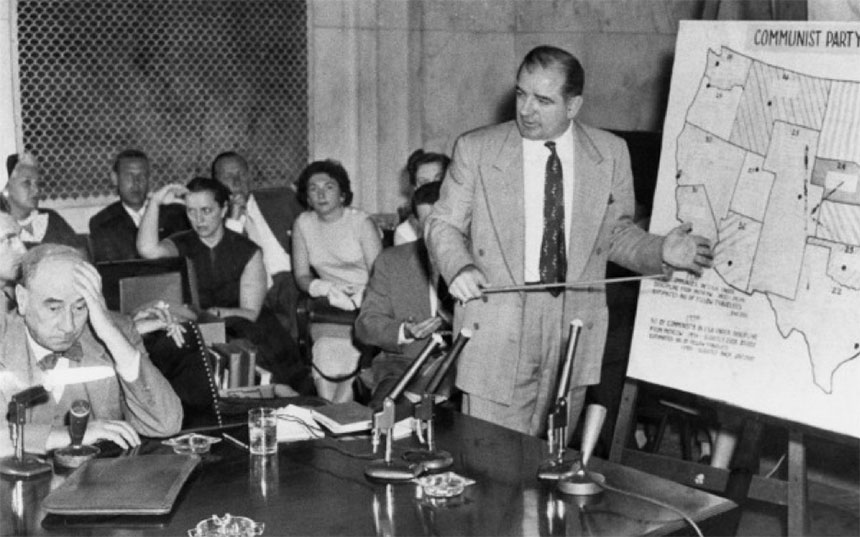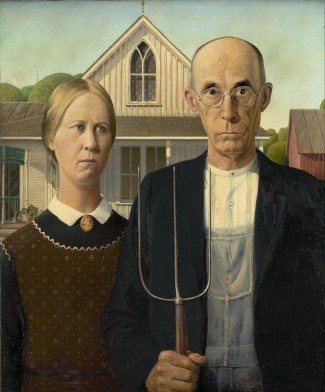Grove City, PA. Soon after Donald Trump’s surprising 2016 election victory, historian Rick Perlstein called for a reassessment of the scholarly portrait of the post-war conservative movement. Writing in the New York Times Magazine, Perlstein confessed that Trump’s success was prompting him to rethink what had become the conventional interpretation of the movement, an interpretation that he himself had helped construct. The standard view focused on conservatism’s intellectual leaders and understood them as principled thinkers who usually eschewed extremism. Trump, of course, appeared not to fit this polite narrative. “If Donald Trump is the latest chapter of conservatism’s story,” Perlstein wondered, “might historians have been telling that story wrong?”[1]
Though not all historians of the movement agree with Perlstein’s mea culpa or his characterization of the historical literature, he is correct that paying more attention to the extremist fringes of the American right and reaching back before World War II could certainly contribute to a deeper, clearer understanding of the rise of Trump. I’d like to suggest that another avenue could also be fruitful regarding conservatism’s founding thinkers: examining those conservative intellectuals who were present at the birth of the modern movement but who came to be sidelined or excluded from its organizations and organs. A fresh look at the paths not taken during the early days of the movement and of the appraisals of conservative critics can bring into clearer relief the essential contours of American conservatism as it subsequently developed. Some early conservative thinkers recognized the potentially toxic elements in the ideological mixture and even foresaw the coming of a nationalist demagogue like Trump. Further, such an approach also highlights the theme of contingency in a narrative that can otherwise take on an air of inevitability.

One of those founders of the postwar conservative movement in America who marked out a different path was poet and historian Peter Viereck (1916-2006). While still in his twenties, Viereck authored a much-discussed article in the Atlantic Monthly (“But – I Am a Conservative!” April,1940) wherein he defended a conservative political and philosophical position. Viereck followed up this initial salvo with Conservatism Revisited in 1949, often numbered among the handful of works that gave rise to the conservative revival following World War II. A gifted writer, Viereck won the Pulitzer Prize for poetry in 1949 and joined the history faculty at Mount Holyoke College in 1948 where he taught for decades. Although a handful of articles on Viereck have appeared since his death, he remains largely ignored both by historians of the conservative movement and certainly by the movement’s leaders. Understandably, scholars have often focused on his unusual family background – Viereck was a descendant of Kaiser Wilhelm I and his father was a notorious Nazi sympathizer.
But the neglect of Viereck’s thought was also initially the product of a concerted effort by a circle of conservatives who sought to read him out of the young movement. William F. Buckley, Jr. was instrumental in defining the postwar conservative cause as a “fusion” of libertarian economics, anti-communism, and cultural traditionalism. Almost from its inception, Viereck had some fundamental reservations about Buckley’s project. Upon graduating from Yale, the precocious Buckley had published in 1951 a scathing critique of his alma mater and, by extension, of the political liberalism of the eastern establishment. He attacked Yale’s faculty and curriculum as undermining traditional American beliefs, especially Christianity and laissez-faire economics. Yale, maintained Buckley, is “neither pro-Christian, nor even, I believe, neutral toward religion.”[2] Further, most of its faculty embraced a state interventionism that undermined free markets and in many cases leaned toward socialism. God and Man at Yale made quite a splash in political and educational circles and has often been viewed as instrumental in the formation of the modern conservative movement.
Viereck was not persuaded. In a sharply critical review of Buckley’s book for the New York Times, he acknowledged some agreement with Buckley. He wrote that the young author was correct “to insist that man has a moral nature, that statism threatens it, that freedom depends on the traditional value-code of the West and that unmoral materialism results in a suicidal tolerance debunking all values as equally ‘relative.’” Nevertheless, he quickly turned to attack Buckley’s conservatism as “nothing more inspiring than the most sterile Old Guard brand of Republicanism, far to the right of [Robert] Taft [Jr.].” Ironically, the agnostic Viereck criticized the Catholic Buckley for equating Manchester economics and Christianity. There were tensions between the two that badly needed to be acknowledged, he contended. If the materialism of communism needed to be refuted, what about materialism’s champions among the National Association of Manufacturers? Moreover, Viereck argued that Buckley oversimplified political differences and produced a Manichean picture of the pure against the impure. Viereck criticized Buckley for “irresponsibly treat[ing] “not only mild social democracy but even most social reform as almost crypto-communism. He damns communism, our main enemy, not half so violently as lesser enemies like the income tax and inheritance tax.” Although Viereck conceded that God and Man at Yale may have been “a necessary counterbalance,” he concluded that the author’s brand of conservatism represented “a shallow . . . booster affirmation” of a rigid and dated partisan position.[3]
I
This caustic review alone did not prompt Buckley’s circle to treat Viereck as an apostate, but it certainly helped. When Buckley founded what became the organ of the new movement in 1955, National Review, Viereck was conspicuously absent from its contributors. By the early 1960s Viereck would articulate a thoughtful critique of the new conservatism, contrasting it with what he understood as his own, more authentic Burkean position. One of the best sources for understanding Viereck’s thinking is his contribution to a revised 1962 edition of Daniel Bell’s 1955 collection, The New American Right. The new volume, now retitled The Radical Right, featured Viereck’s essay, “The Philosophical ‘New Conservatism.’” In contrast to the populism of Joseph McCarthy and the John Birch Society, Viereck saw these emergent conservatives as constituting a genuinely intellectual movement “restricted mainly to the campuses and the magazine world.”[4] In his digressive but idiomatic style, Viereck critically examined the most significant errors and confusions of the so-called new conservatism; his analysis proved to be remarkably prescient. Indeed, it is fruitful to speculate how movement conservatism would have been different had its leaders taken more seriously Viereck’s warnings. His dissent from what would become mainline conservatism illuminates some familiar historical territory in helpful ways.
Viereck began by describing the new sort of conservatism that, happily, took ideas and history seriously. But he complained that its “main defect” was its “rootless nostalgia for roots.” He had in mind here (among others) Russell’s Kirk’s seminal The Conservative Mind: From Burke to Eliot that had first appeared in 1953. Viereck saw the movement as trying to import a reactionary politics from Europe and, in the process, “conjuring up mirages.” When conservatives explored American forerunners, as with the Nashville Agrarians, they were guilty of indulging in a Romantic nostalgia. Instead, Viereck exhorted the new conservatives to seek “living roots” rather than resurrect dead or foreign forebears. He maintained that an authentic Burkean approach would seek to integrate aspects of a moderate Lockean liberalism rather than chase down or fabricate a non-liberal past. Given America’s liberal roots and the more recent legacy of the New Deal, conservatives needed to preserve what was best in the past, rather than insist on ideological purity. At all costs, the new conservatives needed to avoid becoming foreign-style doctrinaires. “The real American conserver,” Viereck remarked, “assimilates into conservatism whatever he finds lasting and good in liberalism and in the New Deal” (190).
American conservatives needed to heed the warnings of Herman Melville and other culturally conservative artists about the fraudulent freedom that was “merely the economic ‘individualism’ of Manchester-liberal pseudo-conservatism” (190). Viereck warned that the movement could easily degenerate into a crude libertarian materialism or “at worst” an authoritarian nationalism (191). He recognized the movement’s temptation to adopt superficial popular stereotypes, rather than dig deeper to preserve underlying eternal principles that he termed “archetypes.” Conservatives badly needed to practice discernment and eschew the artificial stereotypes or idols manufactured by the entertainment industry, which many of them were buying into. Viereck recognized the transformative impact of economic change on eternal principles. Indeed, he maintained that “the sudden uprooting of the archetypes was the most important consequence of the worldwide industrial revolution.” “This moral wound,” he argued, “was even more important than…[its] economic consequences” (192).

No doubt his sharpest criticism of the new conservatives was leveled at their support for Joseph McCarthy’s anti-communist campaign. Viereck placed some of the blame for the Second Red Scare on New Deal liberals. Their failure to be sufficiently anti-communist at a critical juncture had allowed McCarthy, an unprincipled demagogue, to cynically exploit the issue. The governing elite’s dereliction of duty allowed “the bullies and charlatans . . . to fill the vacuum” (194). Yet, incredibly, Buckley had chosen to defend the chief bully and charlatan in his 1954 book (co-written with brother-in-law Brent Bozell) McCarthy and His Enemies: The Record and Its Meanings. While the book gently criticized some of the junior senator’s tactics, it claimed the evidence confirmed McCarthy’s concerns and justified much of his approach. Viereck was appalled both by McCarthy and by his conservative apologists. Simply put, movement conservatives “had failed the acid test of the McCarthy temptation of the 1950s,” a failure on every level—ethical, psychological, and aesthetic (195).
With relief, Viereck listed a few conservatives who had managed to pass the McCarthy test. The list featured mainly academics like himself, including Cornell political scientist Clinton Rossiter who similarly considered the McCarthy moment a crucial test for the movement. When Russell Kirk had invited Rossiter to contribute to National Review at its inception, Rossiter declined emphatically, explaining, “I cannot rid my mind of the spectre [sic] of Bill Buckley and the McCarthy crew. I make no bones about it: I regard McCarthy as the most dangerous and radical force in American political life, and my Conservatism demands that I speak out against him. . . . I do feel this thing to the very depths of my being”[5] Others who had not succumbed to McCarthyism included Chad Walsh, a Beloit College professor and Episcopal priest whose 1946 Atlantic Monthly article had first introduced Americans to the Anglican apologist C.S. Lewis, as well as Neo-Orthodox theologian and public intellectual Reinhold Niebuhr. Viereck described Niebuhr as “conservative in his view of history and anti-modernist, anti-liberal in theology” but not a partisan Republican (197).
Viereck concluded his 1955 essay by exhorting the “new conservatives [to] stop becoming what they accuse liberals of being – rootless doctrinaires” (200). One way to avoid this tendency was to understand their crusade as a battle on at least two different fronts. They needed to fight both “the atomistic disunity of unregulated capitalism” as well as the bureaucratic statism of the socialists (201). Viereck understood English poet Samuel Taylor Coleridge to have best articulated this proper conservative balance between the organic historical political community and the free individual. Viereck complained that “robber-baron individualists” destroyed that balance following the Civil War (202). Moreover, Viereck saw trade unions as one of the best institutional ways to restore “that Coleridgean balance.” Citing Columbia University historian Frank Tannenbaum, he emphasized how the social solidarity and collective action of unions effectively countered “the driving forces operating for the atomization of society and the isolation of man” (Tannenbaum quoted by Viereck 203) The fact that such a sympathetic perspective on the positive role of organized labor “would fill the Kirk-Goldwater kind of mind with horror” represented a damning commentary on the latter’s false brand of conservatism. Despite what the National Review declared, authentic conservatives needed to support trade unionism and other centrist reforms when they helped to forestall radical change. Burke had understood the importance of managed, gradual change but the new rightist doctrinaires plainly did not.
The essay’s last paragraph returned to consider one of the roots of the new conservatism’s problem: its flawed conception of liberty. Its abstract notions of individual liberty owed more to the rationalism of the Enlightenment or the radicalism of the French Revolution than to historic conservatism. Instead, real conservatives needed to embrace specific, historically grounded freedoms, or “concrete liberties, preserved by the chains of ethics, versus abstract liberty-in-quotes, betrayed by messianic sloganizing” (207). Upon correcting their misconception of liberty, genuine conservatives should be able to work cooperatively with a range of individuals, as long as they were committed to representative and constitutional principles. Allied with John Stuart “Mill-style liberals” and even with “democratic Socialists” conservatives could help preserve “rooted tradition and historic continuity” (206-207). History and tradition could thereby be employed to counter the powerful, primary, and instinctive drive or id that seeks only its own immediate advantage, as well as the hyper-individualism of many new conservatives that only produced social chaos.
II
The history of movement conservatism since 1962 provides vivid examples of the sort of defects Viereck describes in his seminal essay. To a large degree, the movement came to bear the dangerous fruit that Viereck anticipated. Indeed, its history confirms some of his dire predictions, especially that of nationalist demagoguery. The Republican Party’s nomination of the libertarian Barry Goldwater for president in 1964 marked out the future trajectory of the movement, even if Goldwater was buried in a Democratic landslide. Curiously, Russell Kirk, among the most prominent spokesmen for the traditionalist wing of the movement (and who had offered sharp criticism of libertarian economics in the 1950s) became a speechwriter for and a close advisor to the Arizona senator. For his part, Goldwater proved his Manchester liberal credentials by campaigning against mandatory Social Security, unionized workplaces, and numerous other aspects of the New Deal legacy. Goldwater’s impatience with the Cold War status quo was expressed in his bellicose calls to escalate U.S. military involvement in Vietnam.
But the campaign’s spirit also displayed a Southwestern populism, especially in Ronald Reagan’s folksy and anecdotal televised speech on behalf of Goldwater, “A Time for Choosing.” Goldwater’s opposition to the Civil Rights Act of 1964 helped him win five states in the deep South. That sectional success prompted a few conservatives to support the more overtly populist candidate four years later on an independent third-party ticket, former Alabama governor George Wallace, a segregationist demagogue of the worst sort. Most movement conservatives naturally retained their ties to a national party that had a reasonable chance to win. Still, they learned from Wallace’s success in the deep South and among white urban ethnics in the North that indirect appeals to racial and cultural concerns could be highly effective. The so-called Southern Strategy shaped the Republican party’s approach to conservative white voters in the Sun Belt for years to come. Reagan built upon the energy generated by this sort of conservative populism to win the White House in 1980.
More recently, during the Barack Obama years, many within the movement redirected their energies away from ethical and culture war issues (where they had made little progress) and toward fiscal matters and stoking fears of socialism. Hence conservatives returned to deficit worries, enthusiastic red baiting, and fringe conspiracy theories such as birtherism. Tea Party groups brought together these assorted concerns to undermine the legitimacy of the nation’s first African American president and portray him as a foreigner pushing an alien ideology. Candidate Obama’s famous confrontation with Joe the Plumber during the 2008 election campaign revealed how the McCarthyite impulse of labelling any tax increase or similar modest reform as socialism was still very much a force within the movement. The exchange also demonstrated how the libertarian wing of the movement had shifted the national conversation by building on Reagan’s attacks on government intervention (“government is the problem”) and repeating libertarian slogans about all taxation being equivalent to theft. Moreover, John McCain’s choice of the anti-elitist Sarah Palin as his vice-presidential candidate in 2008 revealed a willingness to exploit a now unfettered populism. As Perlstein observes, “Republican leaders have always [at least prior to 2016] resisted the urge to go full demagogue. I think they understood that if they did so, it would have very scary consequences. There was always this boundary of responsibility”[6] With Palin, the door to demagogic nativism was opened slightly; with Donald Trump, it was kicked down.
Long after the Senate censured McCarthy, Viereck still feared a “new movement of nationalist demagogy” might arise and called upon conservatives “to co-operate with liberals and New Dealers against right-wing nationalist threats to our shared liberties” (195). During the partisan polarization of the nineties and the aughts, conservatives did just the opposite. Trump certainly appears to have brought together more than a couple of the elements Viereck warned about back in 1962. As Peter Beinhart has commented recently: “Joseph McCarthy, like Trump, built his political career on demagoguery, intimidation, and a cult of personality—not tangible achievements or coherent ideas”[7] The similarities are not insignificant – especially when confirmed by the bizarre fact that McCarthy’s infamous chief counsel Roy Cohn later served as the attorney for Donald Trump’s father Fred. While his articulation of the assorted themes identified by Viereck is often less than coherent, Trump has successfully exploited certain powerful ideas. He has managed to mix together a cocktail of elements that Viereck had once identified as particularly dangerous. The nativist nationalism, the anti-elitist rejection of expertise, an affection for fringe conspiracy theories, and robber baron economics were not unique to Trump, as Viereck helps us recognize. Rick Perlstein’s call to study the right’s extremist edges has merit but examining conservative dissenters such as Viereck (and one should include Clinton Rossiter, among others) can also enrich our portrait of the movement, one that sheds light on its most recent Trumpian variant. The extreme elements were not just on the fringes of the movement but they also contaminated its leaders – something that the movement’s early internal critics understood and about which they issued prophetic warnings.
Rick Perlstein, “I Thought I Understood the American Right. Trump Proved Me Wrong,” New York Times Magazine (April 11, 2017). https://www.nytimes.com/2017/04/11/magazine/i-thought-i-understood-the-american-right-trump-proved-me-wrong.html ↑
William F. Buckley, God and Man at Yale: The Superstitions of ‘Academic Freedom’ (Washington, DC, 1977 [1951]), 4. ↑
Peter Viereck, “Conservatism Under the Elms,” New York Times, November 4, 1951, Section T, 233. ↑
Peter Viereck, “The Philosophical ‘New Conservatism in Daniel Bell, ed. The Radical Right: The New American Right Expanded and Updated (New York, 1963), 185. ↑
Clinton Rossiter, Letter to Russell Kirk, July 19, 1954, file/box uncertain, Papers of Russell Kirk, The Russell Kirk Center for Cultural Renewal (Mecosta, MI) ↑
Isaac Chotiner, “Is This the End of the GOP as We Know It?” Slate, January 28, 2016 https://slate.com/news-and-politics/2016/01/rick-perlstein-historian-of-conservatism-on-donald-trump-and-the-gop-crack-up.html ↑
Rick Perlstein quoted by Peter Beinhart, “Trumpism Is the New McCarthyism.” The Atlantic, July 16, 2020. https://slate.com/news-and-politics/2016/01/rick-perlstein-historian-of-conservatism-on-donald-trump-and-the-gop-crack-up.html ↑













I’ve liked the little I’ve read of Viereck’s work, but I feel that the main reason he wasn’t a force in post-50s conservatism is that he simply didn’t write enough on political subjects to be one. This is no doubt a result of his marginalization, and mostly for bad reasons, but alas, the marginalizing seems to have worked, at least in terms of his output. One wishes that he would have kept writing “from the fringe.”
Gil,
Thanks for this great piece. Sounds like Viereck was an ur-Front Porcher: new conservatives=”rootless doctrinaires” is particularly spot on.
It’s good to see Viereck getting press, especially here at FPR. His writings, and a great lecture he gave at UCLA available online, are all worthwhile and insightful. His Atlantic article “But I’m a Conservative” should be required reading. It also serves as a simultaneous indictment against the once respectable literary & media establishment as well as Movement Conservatism’s utter destruction of anything meaningful in the conservative movement.
Comments are closed.